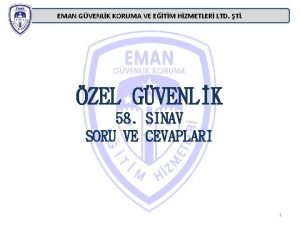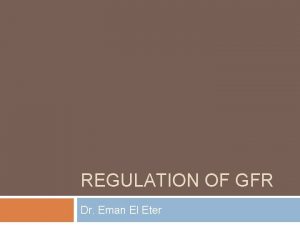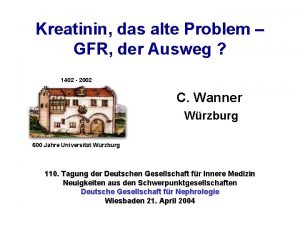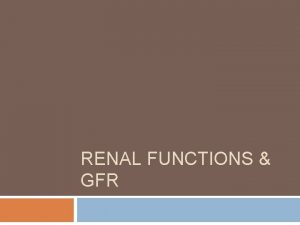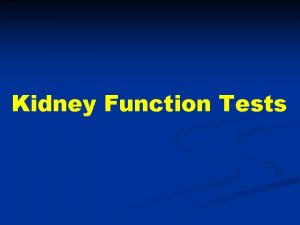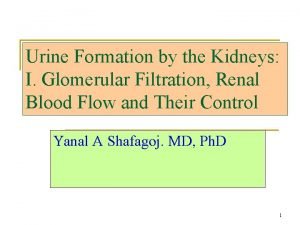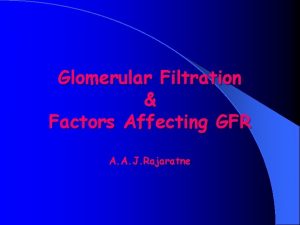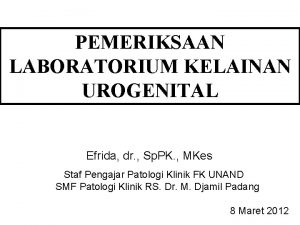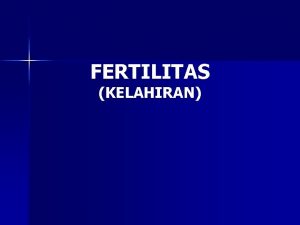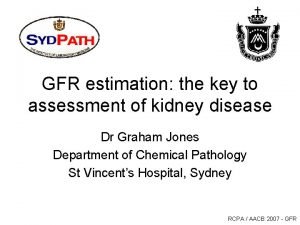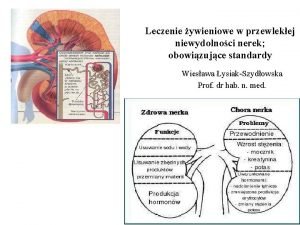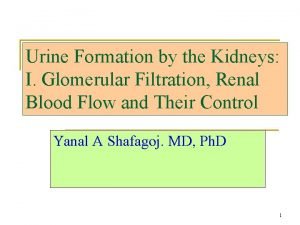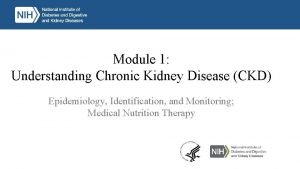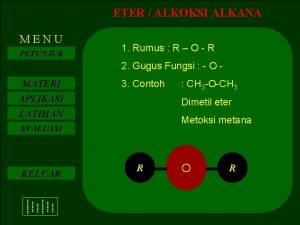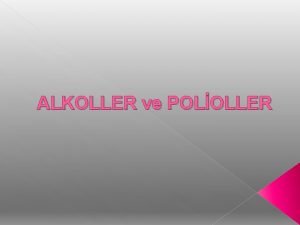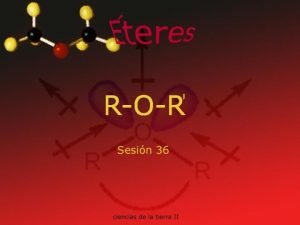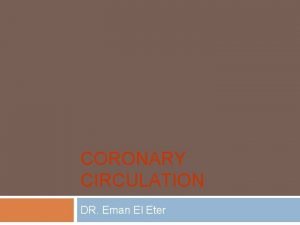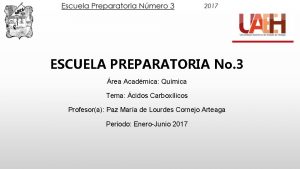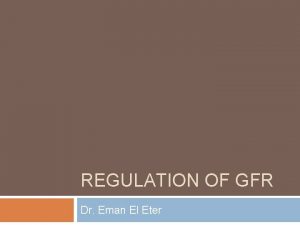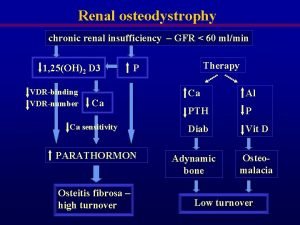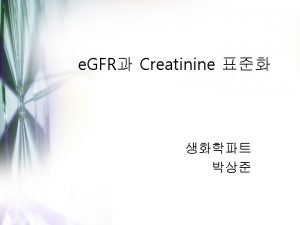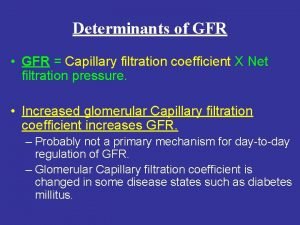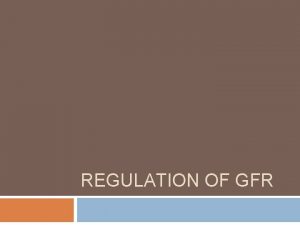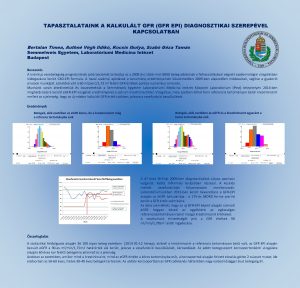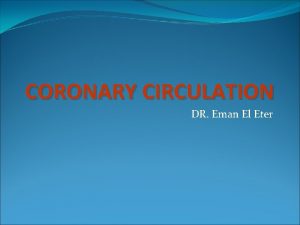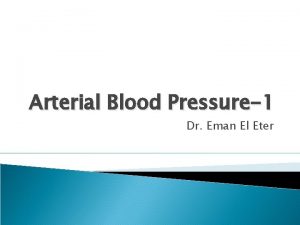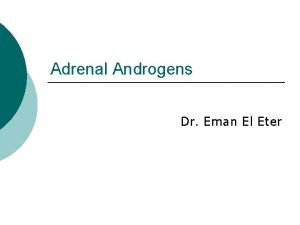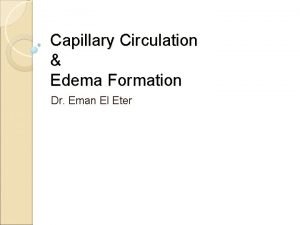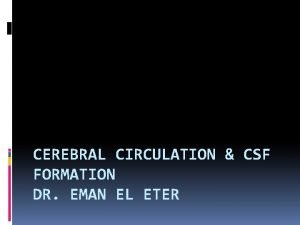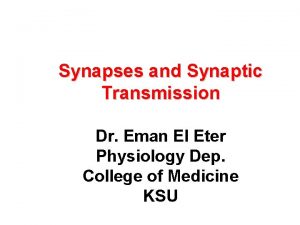RENAL FUNCTIONS GFR Dr Eman El Eter Functions








































- Slides: 40

RENAL FUNCTIONS & GFR Dr. Eman El Eter


Functions of the Kidney Synthetic function Excretion Regulation Blood with metabolic waste products Glucose (gluconeogenesis) Erythropoietin 1, 25 -dihydroxy vitamin D 3 (calcitriol) Renin Metabolic waste products: Urea Creatinine Uric acid Bilirubin Ingested toxins: Drugs Pesticides Water & electrolytes Acid-base Arterial BP

PHYSIOLOGIC ANATOMY OF KIDNEYS • Size Clenched Fist • Weight 150 grams

What is the functional unit of the kidney? The nephron is the functional and structural unit of the kidney. Each kidney has 1 million nephrons, each nephron is capable of urine formation.

Structure of a nephron The Glomerulus: capillary tuft: in which large amount of fluid is filtered from blood. Bwaman’s capsule: Around the glomerulus and receives the filtrate. Tubules: in which filtered fluid eventually is converted into urine.

The Glomerulus Glomerular filtrate collects in capsular space, flows into renal tubule

Structure of a Nephrone 1. Bowman’s capsule 2 - PCT 3 - Loop of Henle. 4 - DCT 5 - Collecting tubules & ducts.

Structure of a nephron, cont…… The renal tubule is divided into different sections with different structural and functional characteristics: Proximal tubules ( in the cortex). Loop of Henle. Distal tubule (in the renal cortex). Connecting tubule, cortical collecting, and the cortical collecting ducts, which run downward in the medulla and become: Medullary collecting ducts.

RENAL BLOOD VESSELS AFFERENT ARTERIOLE: GLOMERULI: CAPILLARY NETWORK THAT PRODUCES FILTRATE THAT ENTERS THE URINARY TUBULES. EFFERENT ARTERIOLE: DELIVERS BLOOD INTO THE GLOMERULI. DELIVERS BLOOD FROM GLOMERULI TO PERITUBULAR CAPILLARIES: VASA RECTA.

Structure of a nephron, cont…. . Types of nephrons: 1 - Cortical nephrons: (85%): Their glomeruli in the outer portion of cortex and have short loops of Henle. . Peritubular capelaries 2 -Juxtamedullary nephrons: (15%): Have long loops extended into the medulla. . Vasa recta Maintain salt gradient, helps conserve water

NEPHRON TYPES Cortical and Juxtamedullary Nephrons 1 -2 % Blood Flows Through Juxta Medullary Nephrons Originates in outer 2/3 of cortex. Originates in inner 1/3 of cortex.

Renal blood flow: Renal blood flow to the kidney represents 20% of cardiac output. The blood flows to each kidney through a renal artery. Features of renal circulation: 1 - High blood flow rate (1200 ml/min). 2 - Presence of two capillary beds: glomerular and peritubular. Efferent and afferent arterioles are major sites of renal resistance.

Urine formation The primary function of the kidney is to ‘clear’ unneeded substances from the blood to be excreted in urine. Steps of urine formation (basic renal processes): 1 - Glomerular filtration: Filtration of fluid from glomerular capillaries into the renal tubules. 2 - Tubular reabsorption 3 - Tubular secretion. 4 - Excretion. Urinary excretion rate = Filtration ratereabsorption+secretion.

1 st Step in Urine Formation

4 1. Filtration RENAL PROCESSES 2. Reabsorption 1. Filtration 2. Reabsorption 3. Secretion 4. Excretion Urinary Excretion Rate = Filtration Rate – Reabsorption Rate + Secretion Rate

Urine Formation Preview

Glomerular filtration rate (GFR) The first step in urine formation is glomerular filtration. It is the filtration of fluid from the glomerular capillaries into the renal tubules. It contains all substances present in plasma except proteins. GFR is normally 125 ml/min = 20% renal plasma flow.

What is glomerular membrane? What will filter? (composition of filtrate) What determine. GFR? What are the forces responsible for passage of fluid (filtrate) through this membrane? Regulation of GFR

Glomerular membrane Blood in the glomerulus is separated from the fluid in the Bowman’s space by a filtration barrier (glomerular membrane) consisting of three layers: 1 - Single layer of capillary endothelium. 2 - Single epithelial lining of Bowman’s capsule (Podocytes) During filtration the fluid moves between their foot processes (psudopodia). 3 - Basement membrane between endothelium and epithelium.

Glomerular membrane Here we see a glomerular capillary in longitudinal section Capillary endothelium

Glomerular membrane Capillary endothelium

Glomerular membrane Basement membrane

Glomerular membrane Podocytes (cell body with nucleus) Filtration slits

FILTRATION MEMBRANE 2. Basement Membrane Filtration 1. Endothelium of Glomerular Capillaries 3. Podocyte

Glomerular membrane

Glomerular membrane

Characteristics of glomerular membrane: Allow passage of molecules up to 70, 000 D Albumin does not normally pass as they are repelled by the negative charge of the glycoproteins material of basement membrane. Blood cells don not normally pass through the membrane.


Glomerular Filtration Rate (GFR) The GFR is determined by: 1 - the net filtration pressure across the glomerular capillaries. 2 - the glomerular capillary filtration coefficient (Kf) GFR = Kf x Net filtration pressure. = 12. 5 X 10 = 125 ml/min

Forces controlling GFR: Starling’s forces • • • The net filtration pressure is the sum of: 1. glomerular hydrostatic pressure (= 60 mm. Hg). It promotes filtration. 2. hydrostatic pressure in Bowman’s capsule (= 18 mm. Hg). It opposes filtration. 3. colloid osmotic pressure of glomerular plasma proteins (= 32 mm. Hg). It opposes filtration. So, net filtration pressure = 60 -18 -32= 10 mm. Hg.

Glomerular Filtration Rate (GFR) What controls (determines) the GFR? Factors related to the membrane itself Permeability GFR = 125 ml/min OR 180 L/day Filtering surface area The sum of the forces acting across the membrane (starling forces) Net filtration pressure (NFP) Capillary filtration coefficient (Kf) GFR = Kf X NFP

Net Filtration Pressure (NFP)

Why is the glomerular hydrostatic pressure higher that the hydrostatic pressure seen in systemic capillary beds?

REGULATION OF GFR

Regulation of GFR = Kf X (PG - � G - PB + � B) Any factor that affect the parameters in the equation will affect the GFR. However, physiologic regulation of the GFR involves mechanisms that affect mainly the PG. Kf � G PB PG depends on: • Arterial BP • Afferent arteriolar resistance • Efferent arteriolar resistance Can get affected in disease conditions causing changes in GFR

How changes in Forces determining GFR affect GFR? • • • - Increased Bowman’s capsule pressure decreases GFR. It can happen in urinary obstruction e. g. stones , tumors. . Increased glomerular capillary colloid osmotic pressure decreases GFR. Increased glomerular capillary hydrostatic pressure increases GFR. This pressure is affected by: ABP. Afferent arteriolar resistance. Efferent arteriolar resistance

Physiologic Regulation of GFR Constriction of Afferent arteriole Constriction of Efferent arteriole ↓↓ PG Moderate Severe ↑↑ PG ↓↓ PG ↑↑ GFR ↓↓ GFR Sympathetic stimulation Epinephrine Norepinephrine Endothelin Angiotensin II

As vasodilation and vasoconstriction of the afferent and efferent arterioles alter the blood flow through the glomerular capillaries, there are corresponding alterations in the glomerular filtration rate (GFR).

Factors affecting Renal blood flow and GFR • • Sympathetic stimulation of renal arterioles decrease GFR & RBF. Norepinephrine decreases GFR & RBF. Angiotensin II decreases RBF. It constricts efferent arteriole more than afferent. High protein diet increases GFR. Hyperglycemia increases GFR & RBF. Fever increases GFR & RBF. Aging decreases RBF & GFR
 Res extra commercium
Res extra commercium Teoria do nefron intacto
Teoria do nefron intacto Eman nayyab
Eman nayyab Eman güvenlik
Eman güvenlik Peritubular capillaries and vasa recta difference
Peritubular capillaries and vasa recta difference Myogenic mechanism kidney
Myogenic mechanism kidney Bakteruri
Bakteruri Gfr wert
Gfr wert Renal cortex
Renal cortex Rumus gfr ginjal
Rumus gfr ginjal Normal creatinine clearance
Normal creatinine clearance Filtration fraction
Filtration fraction Normal gfr by age
Normal gfr by age Factors affecting gfr
Factors affecting gfr Gfr wzór schwartza
Gfr wzór schwartza Wzor cockrofta
Wzor cockrofta Factors influencing gfr
Factors influencing gfr Rumus cct
Rumus cct Kreatin klirensi hesaplama formülü
Kreatin klirensi hesaplama formülü Rumus gfr
Rumus gfr Egfr equation
Egfr equation Rumus tfr dan contoh soal
Rumus tfr dan contoh soal Egfr
Egfr Peritubular capillaries
Peritubular capillaries Nilai gfr normal
Nilai gfr normal Gfr 154 certificate
Gfr 154 certificate éter metilpropílico
éter metilpropílico Metil isopropil eter
Metil isopropil eter Como saber el grupo funcional de un compuesto
Como saber el grupo funcional de un compuesto Penamaan eter
Penamaan eter Tetrasiklin
Tetrasiklin Etoksi isobutana
Etoksi isobutana Eter oluşumu
Eter oluşumu Punctas del eter
Punctas del eter éter divinilíco
éter divinilíco Divergence neurons
Divergence neurons William eter sentezi
William eter sentezi Coronary circulation
Coronary circulation Eter genel formülü
Eter genel formülü Hidrolisis de nitrilos
Hidrolisis de nitrilos Eter
Eter



